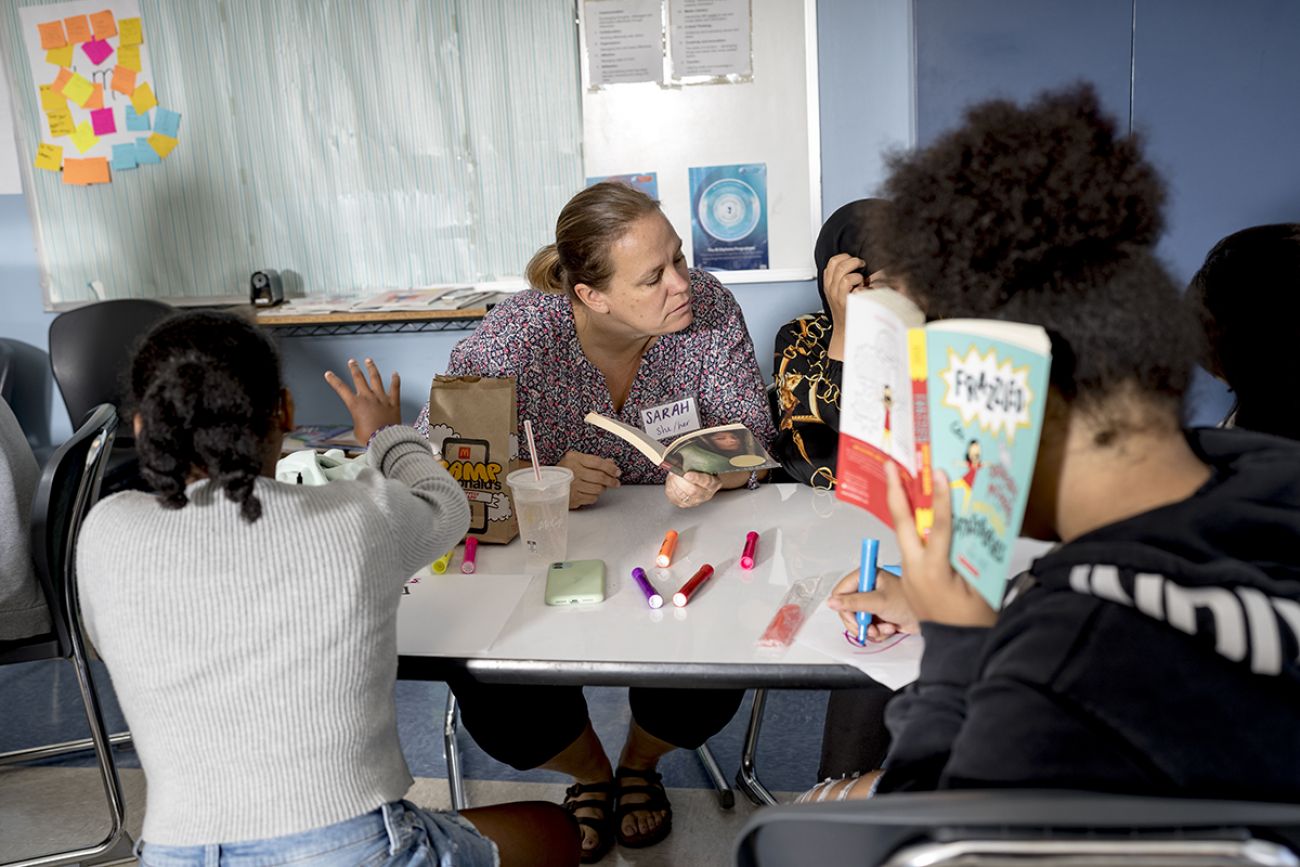Michigan fast-tracks teaching as second career, but questions about rigor

- Michigan is expanding alternative certificate programs to address a shortage of classroom teachers
- Candidates are trained in as little as six weeks
- Some experts say fast-track training is a disservice to the teaching profession and shortchanges students
YPSILANTI – Smitha Ramani leaned over a folding table to whisper encouragement to a student about to give a presentation on her summer school invention: a device that smashes pretend guns and transforms them into pretend cotton candy.
Ramani, a student teacher in the Michigan Alternative Route to Certification program, had been helping summer school students write presentations, create posters, and fill out mock patent applications.

“It’s very difficult for children to articulate what they want to say, so the best way to help them is to ask a lot of questions,” Ramani explained after the Parade of Inventions in the hallways of Willow Run Middle School in Washtenaw County last month.
Related:
- Michigan’s teacher shortage: What’s causing it, how serious is it, and what can be done?
- Short on teachers, Michigan schools try to grow their own
- Facing teacher shortage, Michigan may ease path for out-of-state educators
Three weeks earlier, Ramani’s day looked much different. She was behind the pharmacy counter in a Livonia Rite Aid, juggling phone calls from doctors’ offices, answering patient questions about drug interactions, and filling prescriptions for azithromycin, Adderall and all sorts of other medications.
She’s giving up her career in pharmacy to do something she believes will be more rewarding: teaching.
Ramani is among 39 students in a new Initial Certification Pathway, an expansion of the Alternative Route to Certification program at the University of Michigan that previously prepared teachers only in the Detroit metropolitan area. The new pathway serves prospective teachers from all areas of the state. It’s one of a growing number of programs in Michigan to help people with bachelor’s degrees in other fields quickly become certified educators.
Alternative certification programs are becoming more common nationwide partly as a response to concerns about a potential teacher shortage. In Michigan, two new programs opened last year, bringing the total number of state-approved programs to 10.

The number of prospective educators enrolling in these programs is growing, too. There were 1,935 students enrolled in Michigan programs in 2019-20, according to the most recent data available. Five years earlier there were just 95 enrollees.
The programs provide expedited routes to certification, sometimes in as little as six weeks.
Program completion, along with passage of the Michigan Test for Teacher Certification, qualifies participants for interim teaching certificates, which carry the same rights and responsibilities as standard certificates. After three years, during which the teachers receive additional mentoring and professional development, they can be fully certified.
In the Michigan Alternative Route to Certification, known as M-ARC, candidates spend five months in online courses and two weeks student teaching under the watch of field instructors, who provide daily feedback.
That’s a fraction of the time required to complete a four-year education degree. At $9,000, it’s also a fraction of the cost.
“We’re opening access to teacher certification to people for whom a traditional pathway isn’t accessible, either for geographic reasons, for financial reasons, or for time reasons,” said Jean Mrachko, the M-ARC program’s associate director. “It allows people to be working in the field while they are completing the program. That really opens access.”
Critics wonder if expedited programs shortchange teachers and the children they will later serve. They worry that such programs compromise standards and dilute teacher preparation curricula.
“Are they looking to make it easier and quicker to become a teacher?” asked Thomas Morgan, spokesman for the Michigan Education Association. “If that’s the case, it’s not rigorous enough. … We believe there needs to be a hill to climb to become a teacher.”
The National Council on Teacher Quality does, too.
“We should not be lowering the bar for getting into teaching right now,” said NCTQ President Heather Peske. “Given the data we’re seeing on learning loss during the pandemic, we need the most skilled, the most qualified, the most committed teachers entering schools right now."
Proponents including state Superintendent Michael Rice see alternative route programs as a key part of the solution to the shortage of teachers plaguing many districts across the state as they work to make up for lost learning opportunities during the pandemic.
“I view it as responding to the moment,” Rice said. “If the question is whether we have a teacher that is certified through (an alternative route) or have Mikey from the curb teaching a child —– a person who has no experience whatsoever and is simply an adult substituting in a classroom for a long period of time because there isn’t a math teacher, there isn’t a social studies teacher, there isn’t a science teacher — the teacher that is developed through an alternative route program or expedited program is going to be preferable.”
That’s not to say they are preferable to someone with a four-year teaching degree, he added.
“People have to have ways to break into the profession” that don’t require four years, Rice said. “There have to be multiple onramps to the profession based on multiple sets of experiences, competencies, and knowledge bases.”
Providers say their training programs are comprehensive.
“We are not sacrificing the quality of the preparation. We’re doing it on a different timeline and at a different price point,” Mrachko said.
She said students said course content is comparable to traditional education classes at the University of Michigan, but M-ARC participants are relieved from taking courses in content areas because they already have bachelor’s degrees and have demonstrated competency on Michigan Test for Teacher Certification subject-area tests. Many also have work experience in the fields they want to teach.
“There are benefits to doing four years of an education program and then becoming a teacher, but why would you think that people like me won’t be successful?” Ramani asked. “We are coming into the profession with not a lot of school experience but with other experiences, life lessons, and passion most of all.”
M-ARC administrators know Ramani and her classmates will need intensive ongoing support during the three years they will work under interim certificates.
“We don’t just drop them off at a school door and wish them luck,” Mrachko said. “We hold their hands and walk in beside them.”
Students undergo six classroom observations a year, continue to attend twice monthly M-ARC seminars, create teaching portfolios, and complete assignments that ask them to reflect on their teaching, Mrachko said. They also have experienced colleagues in their school buildings who serve as mentors.
Academics like Brent Maddin acknowledge the tension between resolving the teacher shortage and maintaining standards.
“It’s really complicated because at this moment in American history — world history — we need to ensure that all students have access to the best educators they’ve probably ever needed,” said Maddin, a professor and director of Next Education Workforce at Arizona State University.
Sarah DePriest, 46, of Willis in Washtenaw County has felt that tension.

While working a part-time job in the office at Lincoln Consolidated School District near Ann Arbor, she saw how desperate administrators were to staff classrooms. So she pitched in as a long-term substitute teacher. She soon realized she could contribute more as a full-time teacher, but only if she could find a certification program that would prepare her quickly enough to help but also well enough for her to feel confident leading her own classroom.
M-ARC seemed to fit the bill, although she still wonders if two weeks of student teaching would have been enough if she hadn’t already had experience as a sub.
“It was a great experience, but it wasn’t like having your own class,” said DePriest, who previously worked in restaurant management and as associate director of a nonprofit humanitarian organization, MOST Ministries. “Being in a classroom is different than any job I’ve ever had.”
She and other M-ARC participants said they wish they’d had more practice teaching students, managing classrooms, and writing lesson plans. Even during their student teaching, practice was limited. They worked in teams of three or four with a certified teacher and a field instructor from the university who critiqued their teaching and offered suggestions for improvement.
Critics of alternative route programs say students deserve teachers who’ve had more practice than that.
“I would absolutely acknowledge that as a valid point,” said M-ARC student Mark Smith, of Grand Rapids. “On the other hand, I have experienced so many different areas of life, that I have a lot more reference points to connect with students” than most traditionally prepared teachers, he said.

Before enrolling in M-ARC, he spent decades working in sales, finance, marketing, SAT tutoring, and most recently as a behavioral health technician in a mental health program for teens.
Classmate Edgar Watson, 53, of Ann Arbor, knew from a young age that he wanted to be a teacher like his father, but his dad and other teachers he knew dissuaded him. They said the job is stressful and not well paid.
So he stayed away from teaching. Instead he earned a degree in computer engineering and then took a series of jobs leading his church’s music ministry, photographing weddings, and working as a chemical operator in an ink plant.
When he learned that districts near him were struggling to staff schools after last year’s return to in-person learning, he signed up as a substitute. He spent his days following lesson plans other people had written, and doing his best to manage a different class of students at a different school every day.

“It got me thinking,” Watson said. “I said, ‘I wonder what would be different if I were the real teacher in this room? I wonder what the dynamic would be if I had access to the grades, and the parents, and the union for that matter — everything. What could I really do?’”
That’s what led him to M-ARC.
His classmates have worked in construction, food service, journalism, library science, and more. Eleven have master’s degrees and one is a step away from having a PhD. Their average age is 39.
“It’s courageous, what they’re doing, especially people who have previously been near the top of their field or have been in leadership positions,” Mrachko said. “To step back and be the new guy who doesn’t know as much as the (colleagues) who are much younger, it’s a potential challenge, and it’s humbling. It takes a particular mindset.”
Ramani, 43 of Ann Arbor, said she and her M-ARC classmates have that mindset.
“We know what we’re getting into,” she said. “We’re getting into it because of a passion for the idea of inspiring someone – building the next generation of humans.”
Michigan Education Watch
Michigan Education Watch is made possible by generous financial support from:
Subscribe to Michigan Education Watch
See what new members are saying about why they donated to Bridge Michigan:
- “In order for this information to be accurate and unbiased it must be underwritten by its readers, not by special interests.” - Larry S.
- “Not many other media sources report on the topics Bridge does.” - Susan B.
- “Your journalism is outstanding and rare these days.” - Mark S.
If you want to ensure the future of nonpartisan, nonprofit Michigan journalism, please become a member today. You, too, will be asked why you donated and maybe we'll feature your quote next time!






